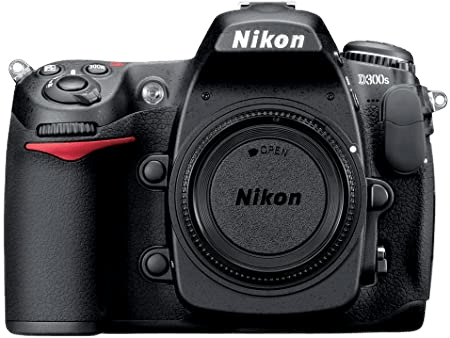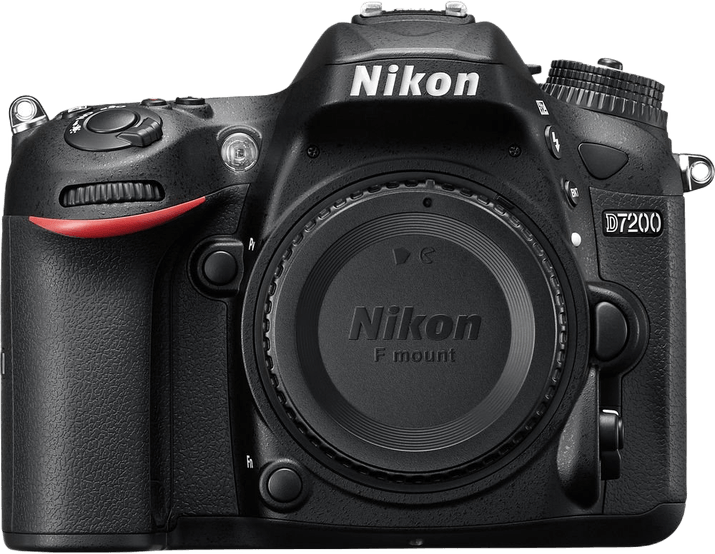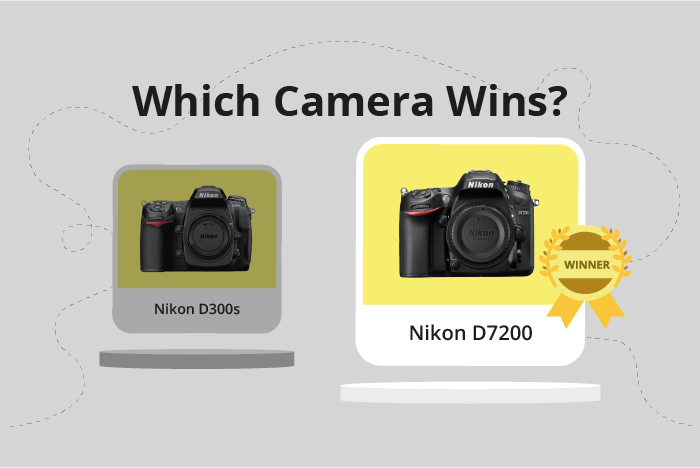Nikon D300s vs D7200 Comparison
Nikon D300s

Nikon D7200

The Nikon D7200 outperforms the Nikon D300s with a score of 68/100 compared to 53/100. Both cameras are DSLRs and share some common specifications. The D7200 is lighter at 765g and smaller with dimensions of 136 x 107 x 76mm, making it more portable. Additionally, it was released in 2015 at a lower launch price of $1200, offering better value.
The D300s, released in 2009, is heavier at 938g and larger at 147 x 114 x 74mm. Its launch price was $1815, which is significantly higher than its counterpart. However, it may still appeal to those who prefer a more solid and robust build.
Considering the better score, lighter weight, smaller size, and lower price, the Nikon D7200 is the superior choice for most photographers. On the other hand, the Nikon D300s may suit those who prioritize a more substantial and sturdy camera.
Nikon D300s vs D7200 Overview and Optics
The Nikon D7200 wins in the optics comparison with a score of 71/100, while the Nikon D300s scores 50/100. Both cameras share some common specifications: they have the same APS-C sensor size, Nikon F DX lens mount, and lack of image stabilization. However, there are notable differences that make the D7200 a better camera in terms of optics.
The Nikon D7200 has a higher megapixel count at 24.2, compared to the D300s with 12.3 megapixels. This means the D7200 captures more detail and produces higher resolution images. Additionally, the D7200 has a more advanced Expeed 4 processor, which contributes to faster image processing and better overall image quality. The D7200 also boasts a higher DXOMARK sensor score of 87, reflecting its superior image quality and low-light performance.
While the Nikon D300s falls behind in these aspects, it does have a slightly faster shooting speed of 7 frames per second compared to the D7200’s 6 frames per second. This could be beneficial for capturing fast-moving subjects or action shots.
Considering the differences in optics, the Nikon D7200 emerges as the clear winner due to its higher megapixel count, more advanced processor, and better sensor performance. The D300s does have a minor advantage in shooting speed, but it is not enough to outweigh the significant improvements in image quality offered by the D7200. Therefore, for those prioritizing optics, the Nikon D7200 is the superior choice between the two cameras.
Nikon D300s vs D7200 Video Performance
When comparing the Nikon D300s and the Nikon D7200, it is important to note that the D300s does not have video functionality. This means that if you are looking for a camera with video capabilities, the D300s will not be able to meet your needs in this regard. On the other hand, the Nikon D7200 has a video score of 70/100, offering a range of video features for users to enjoy.
The Nikon D7200 provides Full HD video with a maximum resolution of 1920 x 1080. This ensures that users can capture high-quality videos with their camera. In addition to this, the D7200 offers a maximum video frame rate of 60fps, allowing for smooth and clear video footage. One notable feature of the D7200 is its built-in time-lapse functionality, which enables users to easily create stunning time-lapse videos without the need for additional software or equipment.
Given the lack of video functionality in the Nikon D300s, the Nikon D7200 stands out as the superior choice for those seeking a camera with video capabilities. With its high-quality Full HD resolution, 60fps frame rate, and built-in time-lapse feature, the D7200 is well-equipped to meet the needs of users looking to capture both still images and video footage.
Nikon D300s vs D7200 Features and Benefits
The Nikon D7200 emerges as the winner in the features comparison, scoring 59 out of 100, while the Nikon D300s scores slightly lower at 54.
Both cameras share some specifications: they have no touchscreen, no flip screen, and no GPS. However, the Nikon D7200 has a larger screen size of 3.2 inches compared to the Nikon D300s’ 3-inch screen. The D7200 also boasts a higher screen resolution of 1,228,800 dots, whereas the D300s has a resolution of 920,000 dots. Additionally, the Nikon D7200 is equipped with WIFI, a feature absent in the Nikon D300s.
The Nikon D7200’s larger screen size and higher resolution offer a clearer and more detailed image preview, which is advantageous for photographers. The WIFI capability also allows for easy photo sharing and remote camera control, enhancing the overall user experience.
On the other hand, the Nikon D300s does not have any notable advantages over the Nikon D7200 in terms of features. The absence of WIFI and a lower screen resolution make it less appealing compared to the D7200.
In comparing the Nikon D7200 and D300s, the D7200 stands out with its larger screen size, higher resolution, and WIFI capabilities, while the D300s does not offer any significant advantages. This comparison reveals that the Nikon D7200 is the better choice for photographers seeking enhanced features and a more enjoyable user experience.
Nikon D300s vs D7200 Storage and Battery
The Nikon D7200 outperforms the Nikon D300s in storage and battery with a score of 79/100 compared to the D300s’s 76/100. Both cameras share common features, such as having two memory card slots and not offering USB charging. However, the D7200 accepts SD, SDHC, and SDXC memory cards, providing more storage options than the D300s, which only accepts SD, SDHC, and Compact Flash cards.
The D7200 also boasts a longer battery life, allowing for 1110 shots with its EN-EL15 battery, as opposed to the D300s’s 950 shots using the EN-EL3e battery. The D300s does not have any advantages over the D7200 in terms of storage and battery.
Considering these factors, the Nikon D7200 offers better storage and battery options, making it the superior choice between the two cameras in this aspect.
Nikon D300s vs D7200 – Our Verdict
Are you still undecided about which camera is right for you? Have a look at these popular comparisons that feature the Nikon D300s or the Nikon D7200:

